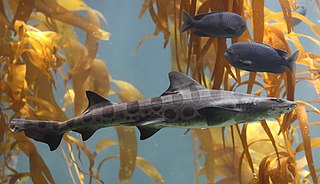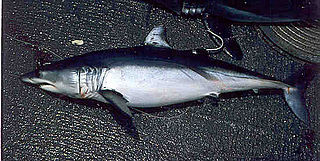
The bullhead sharks are a small order of modern sharks (Neoselachii). The nine living species are placed in a single genus, Heterodontus, in the family Heterodontidae. All are relatively small, with the largest species reaching just 1.65 metres (5.5 ft) in maximum length. They are bottom feeders in tropical and subtropical waters.

Carpet sharks are sharks classified in the order Orectolobiformes. Sometimes the common name "carpet shark" is used interchangeably with "wobbegong", which is the common name of sharks in the family Orectolobidae. Carpet sharks have five gill slits, two spineless dorsal fins, and a small mouth that does not extend past the eyes. Many species have barbels.

The Ginglymostomatidae are a cosmopolitan family of carpet sharks known as nurse sharks, containing four species in three genera. Common in shallow, tropical and subtropical waters, these sharks are sluggish and docile bottom-dwellers. They are the most abundant species of shark found in shallow coastal waters. Nurse sharks typically attack humans only if directly threatened.

Heptranchias is a genus of sharks in the family Hexanchidae.

Echinorhinus is the only extant genus in the family Echinorhinidae.
Centrophorus is a genus of squaliform sharks. These deep-water sharks, found in temperate and tropical oceans throughout the world, are characterized by grey or brown bodies, large green eyes, and spines on both dorsal fins. These spines give them their name, from Greek κεντρον, kentron meaning "thorn" and φέρειν, pherein meaning "to bear".
Deania is a genus of long-snouted, deepwater dogfish sharks in the family Centrophoridae.

The nurse shark is an elasmobranch fish in the family Ginglymostomatidae. The conservation status of the nurse shark is globally assessed as Vulnerable in the IUCN List of Threatened Species. They are considered to be a species of least concern in the United States and in The Bahamas, but considered to be near threatened in the western Atlantic Ocean because of their vulnerable status in South America and reported threats throughout many areas of Central America and the Caribbean. They are directly targeted in some fisheries and considered by-catch in others.
Hemipristis is a genus of weasel sharks, family Hemigaleidae. It contains one extant species, the snaggletooth shark and several extinct species.

The tawny nurse shark is a species of carpet shark in the family Ginglymostomatidae, and the only extant member of the genus Nebrius.

The sixgill sawshark, Pliotrema warreni is a sawshark of the family Pristiophoridae. Presence of 6 pairs of gill slits highlights this genus among sharks; outside Hexanchiformes order, Pliotrema is the only shark with more than 5 gill slits. Unlike other sawsharks, the barbs on this shark's rostrum continue onto the sides of the head. Its barbels are also closer to its mouth than in other species. At maximum, females can reach over 136 cm long, and males can reach over 112 cm long.

The hooktooth shark, is a weasel shark of the family Hemigaleidae, the only extant member of the genus Chaenogaleus, but there is an extinct species, Chaenogaleus affinis. The hooktooth shark is found in the tropical Indo-West Pacific oceans between latitudes 30° N and 10° S, including the Persian Gulf, Pakistan, India, Sri Lanka, Singapore, Thailand, Viet Nam, China, Taiwan, and Java and Sulawesi in Indonesia, from the surface to a depth of 59 meters. It can reach a length of 1 meter. It is considered a vulnerable species.

Triakis is a genus of houndsharks in the family Triakidae. The name comes from the Greek word τρι, tri meaning "three", and the Latin word acis meaning "sharp" or "pointed", in reference to the three-pointed teeth of these sharks.

Oxynotus is a genus of sharks in the order Squaliformes, commonly known as the rough sharks. It is the only extant genus in the family Oxynotidae. They live in deep waters in the Atlantic and western Pacific Oceans.

Lamna is a genus of mackerel sharks in the family Lamnidae, containing two extant species: the porbeagle of the North Atlantic and Southern Hemisphere, and the salmon shark of the North Pacific.

Isurus is a genus of mackerel sharks in the family Lamnidae, commonly known as the mako sharks.

Aetobatus is a genus of eagle rays native to the Atlantic, Pacific and Indian Oceans. It was formerly placed in Myliobatidae, but is now placed in its own family Aetobatidae based on salient differences from myliobatids, especially the pectoral fins joining the head at the level of the eyes.

Otodus angustidens is a species of prehistoric megatoothed sharks in the genus Otodus, which lived during the Oligocene and Miocene epochs about 33 to 22 million years ago. The largest individuals were about 11–12 metres (36–39 ft) long. This shark is related to another extinct megatoothed shark, Otodus megalodon.

Cosmopolitodus is an extinct genus of mackerel shark that lived between thirty to one million years ago during the late Oligocene to the Early Pleistocene epochs. Its type species is Cosmopolitodus hastalis, the broad-tooth mako. In 2021, Isurus planus was reassigned to the genus, and thus became the second species C. planus. Its teeth can reach lengths up to 3.5 in (7.5 cm) and are found worldwide. It is believed to be an ancestor to the great white shark, an argument supported by the transitional species Carcharodon hubbelli, but as of 2021, no phylogenetic analyses have been done for proof.

Nemacanthus is an extinct genus of prehistoric sharks in the family Palaeospinacidae.

















